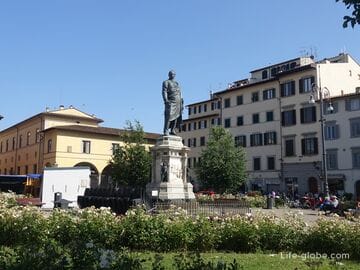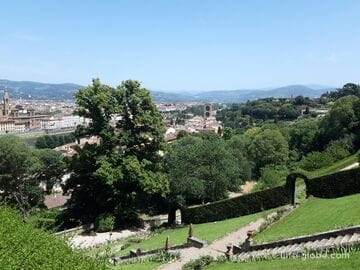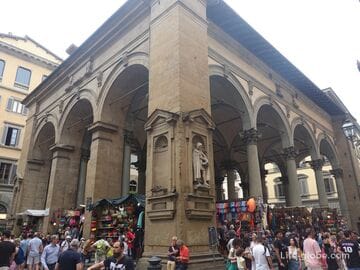Duomo Square or Cathedral Square (Piazza del Duomo) and Piazza San Giovanni or St. John's Square (Piazza di San Giovanni) are the main and most visited squares of Florence, where the main monuments of the city, included in the UNESCO World Heritage List, are concentrated.
The Duomo and San Giovanni squares cannot be considered separately, since they are located next to each other (one square invisibly flows into another) and visually are one large and important space of Florence.
The squares are located in the historical center of the city and form the heart of Florence, where giants rise, acting as the dominant and religious ensemble of the city, surrounded by historical buildings, including former palaces and loggias.
This is one of the most beautiful and visited places in Europe and the world, and Florence is the most visited part of the city.
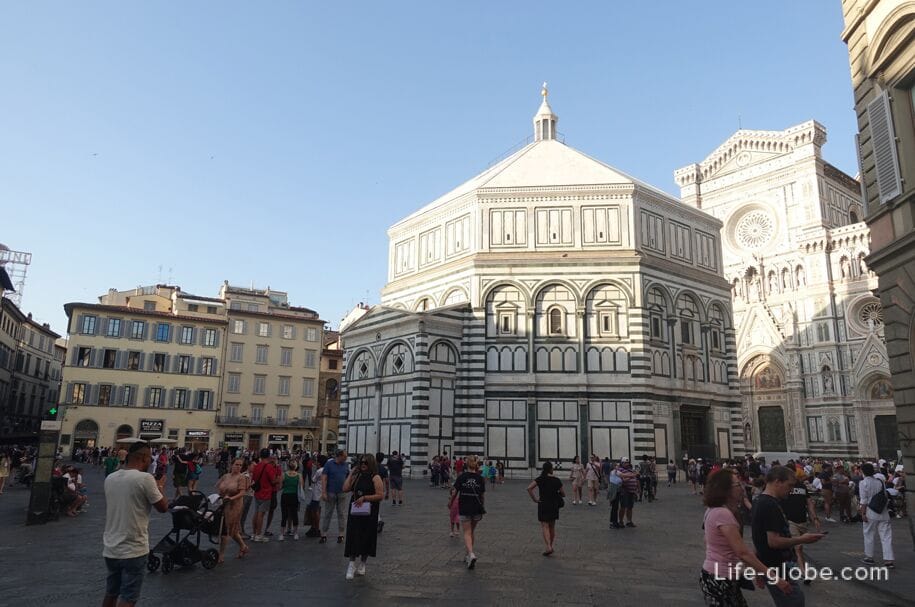

Since ancient times, this place has been the religious center of Florence, since the first city cathedral was located here.
The current changes of the square began to be carried out from the end of the 13th century, when the construction of a new cathedral was started, for which some buildings were demolished, and the square was expanded. In the 19th century, the Piazza San Giovanni was expanded.
Since October 25, 2009, the square has become completely pedestrian.
Today, the square attracts many tourists like a magnet. The square is always crowded. Here, among the history of the city, there are cafes and restaurants with outdoor tables, shops and souvenir shops, museums and viewing platforms, as well as accommodation facilities (hotels, apartments)
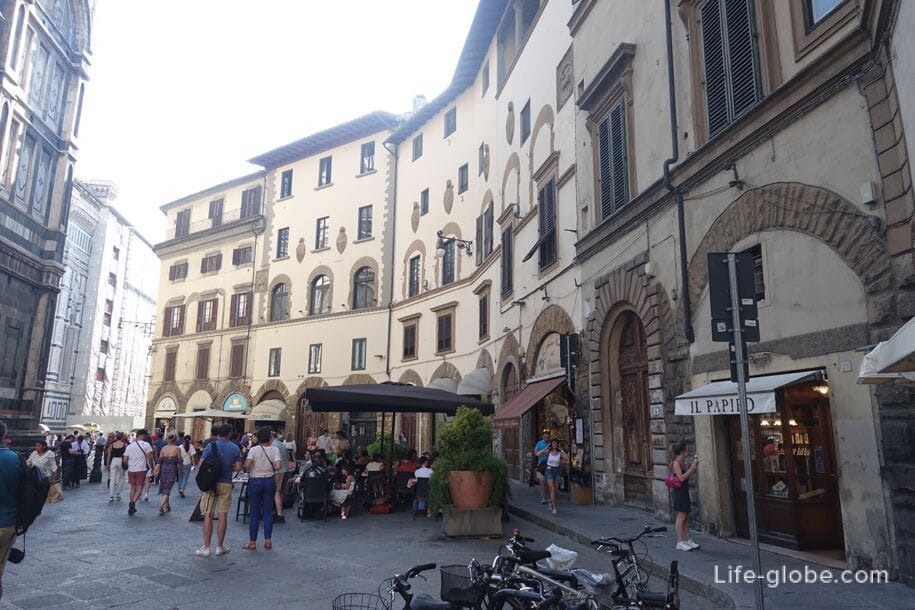
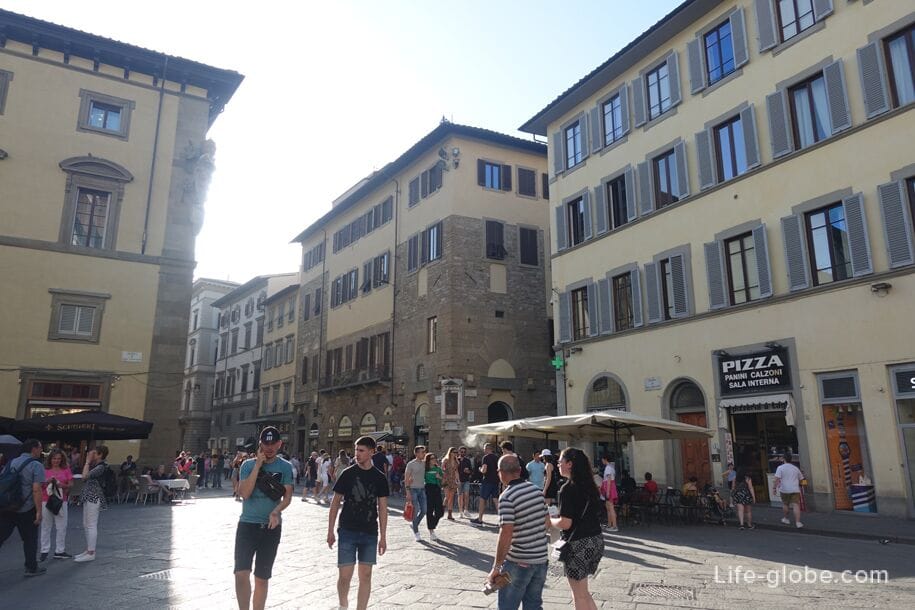
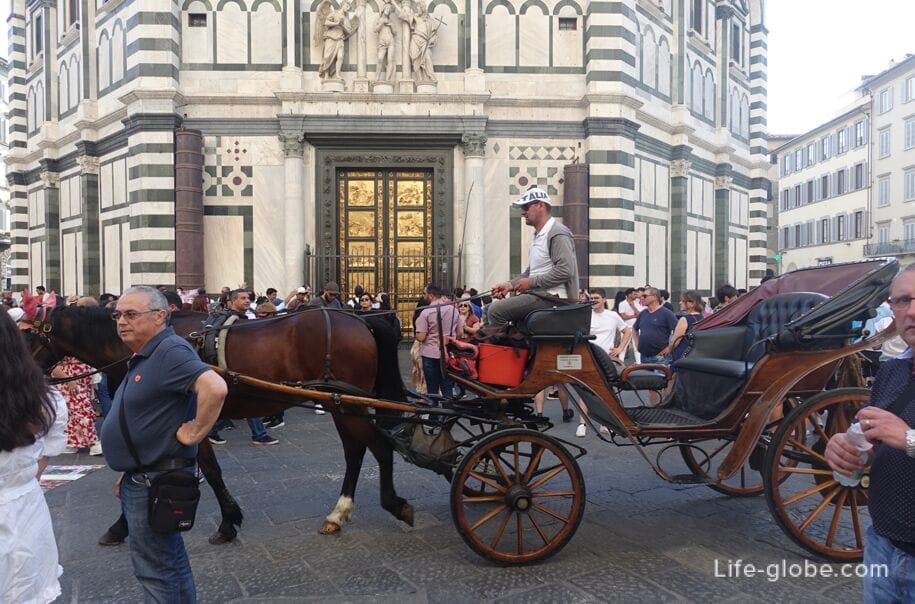
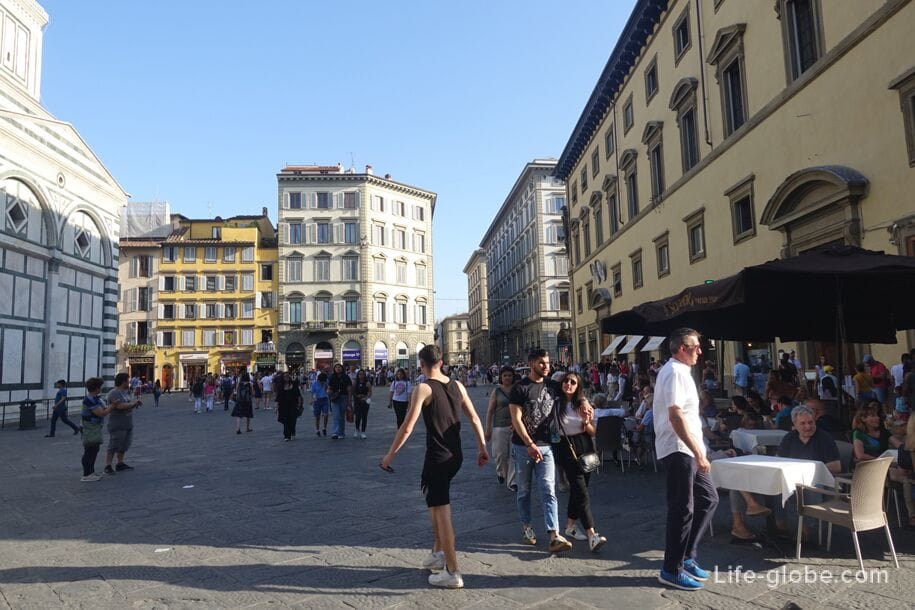

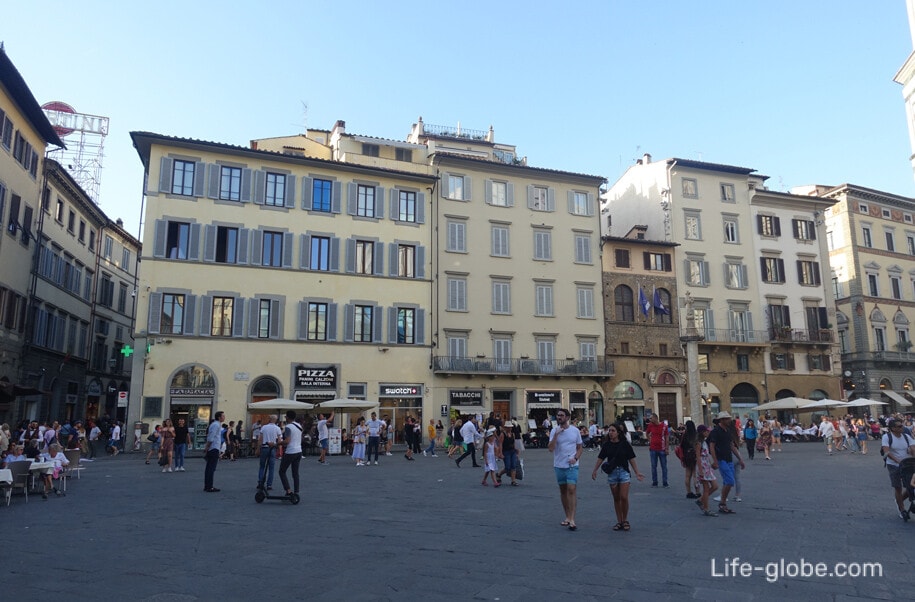


If the Duomo Square with its continuation, St. John's Square, is the religious center of Florence, then two other squares located nearby complement it. This is the Piazza della Signoria, serving as the center of the political and social life of the city and the Republic Square, which was the main shopping area of Florence. Together, these three squares represent the trio of the heart of Florence.
It is worth mentioning the fourth significant and visited square in Florence, Michelangelo Square, which was created in modern times. It is located on the opposite side of the Arno River and is one of the best and most famous observation platforms of the city.
The main ensemble of the Duomo and San Giovanni squares
The main ensemble of squares is dominated by the Cathedral of Santa Maria del Fiore and related objects such as the Giotto Bell tower, the Baptistery of San Giovanni, the crypt of the former Cathedral of Santa Reparata and the Opera Duomo Museum, which together are a magnificent complex of Florence Cathedral and the main attraction of the city.
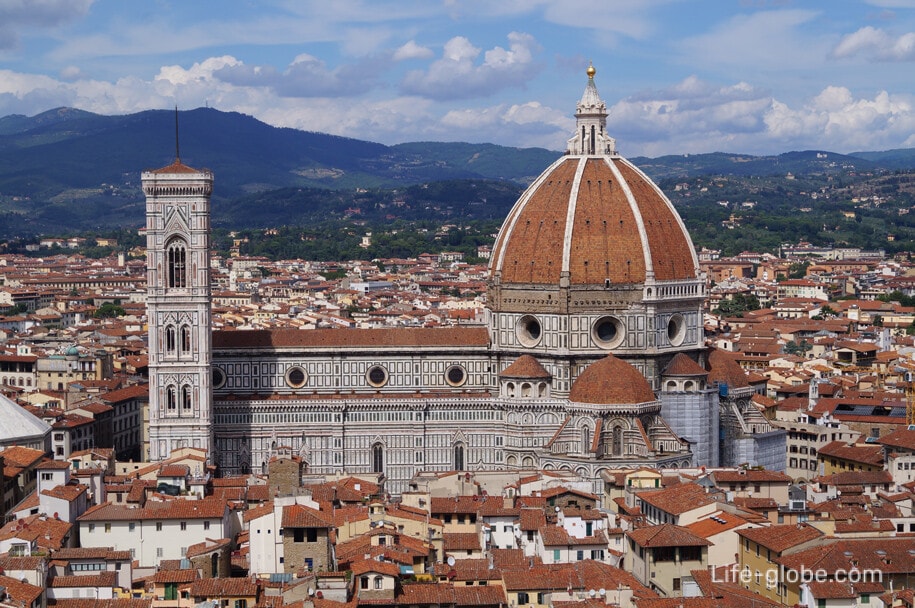
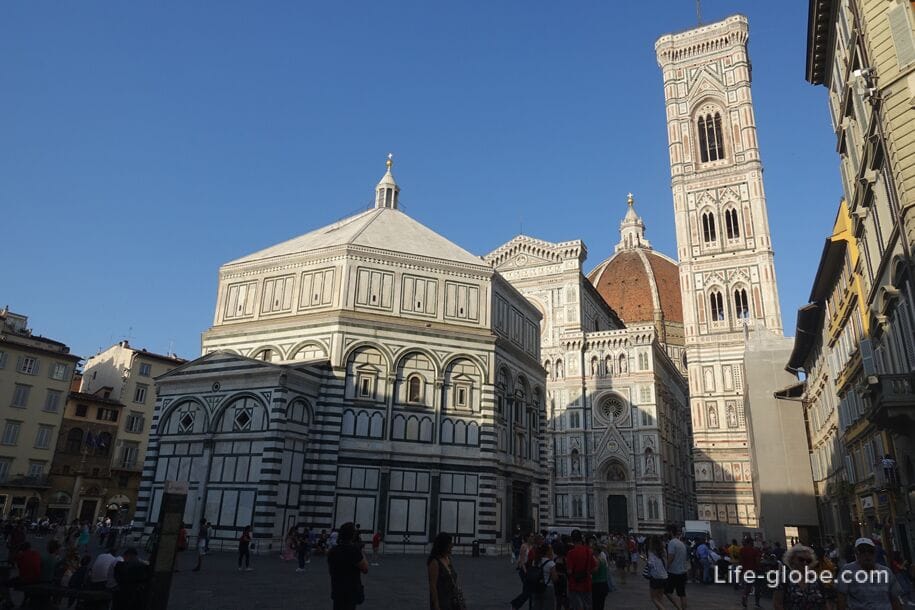
Cathedral of Santa Maria Del Fiore
Florence Cathedral, whose full name is Santa Maria del Fiore (La Cattedrale di Santa Maria del Fiore, translated as St. Mary's Cathedral with a flower) is the main (cathedral) cathedral of Florence (Duomo of Florence), which is a symbol of the city and a magnificent example of Florentine architecture Quattrocento.
The history of the cathedral dates back to the end of the 13th century, when it was erected over the remains of the earlier church of Santa Reparata.
The cathedral impresses with its grandeur and beauty, thanks to the luxurious cladding of the facades of the walls on all sides of the cathedral, made of multicolored marble panels of geometric pattern in various shades: white marble (from Carrara) green (from Prato) and pink (from Maremma). Also, the exterior of the cathedral has sculptural and architectural decorations.
The interior of the cathedral, on the contrary, is quite strict and modest, but creates the impression of an infinite space and has some architectural masterpieces. More about Santa Maria del Fiore Cathedral...
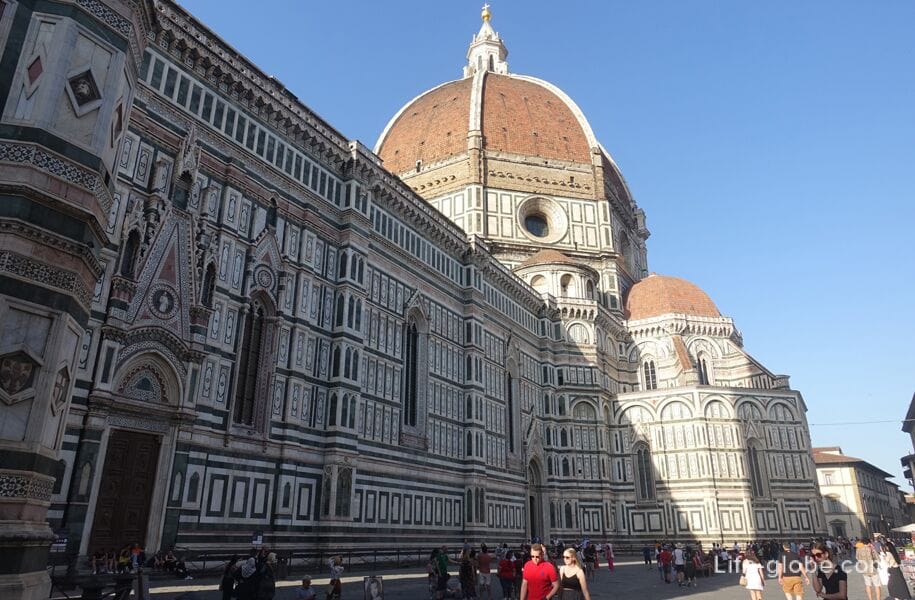
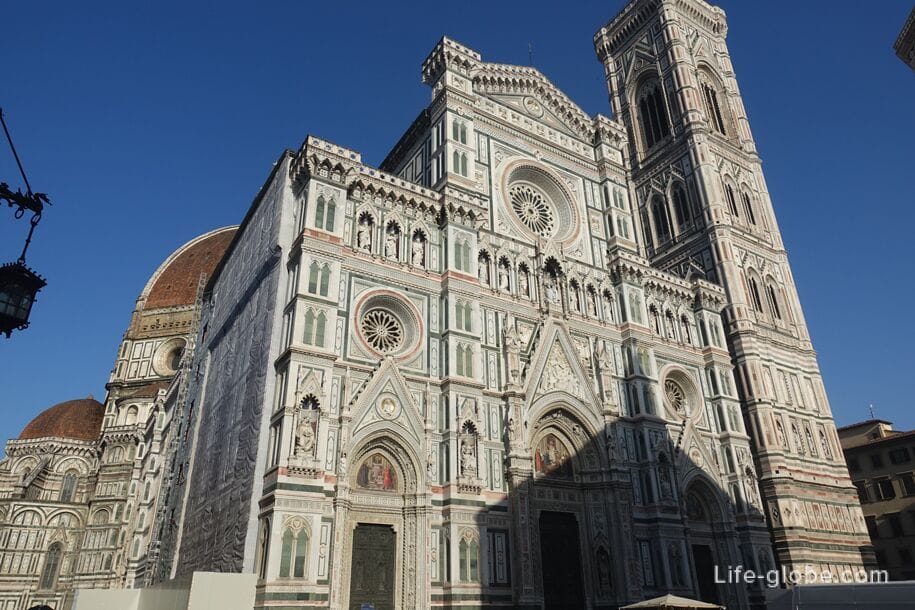
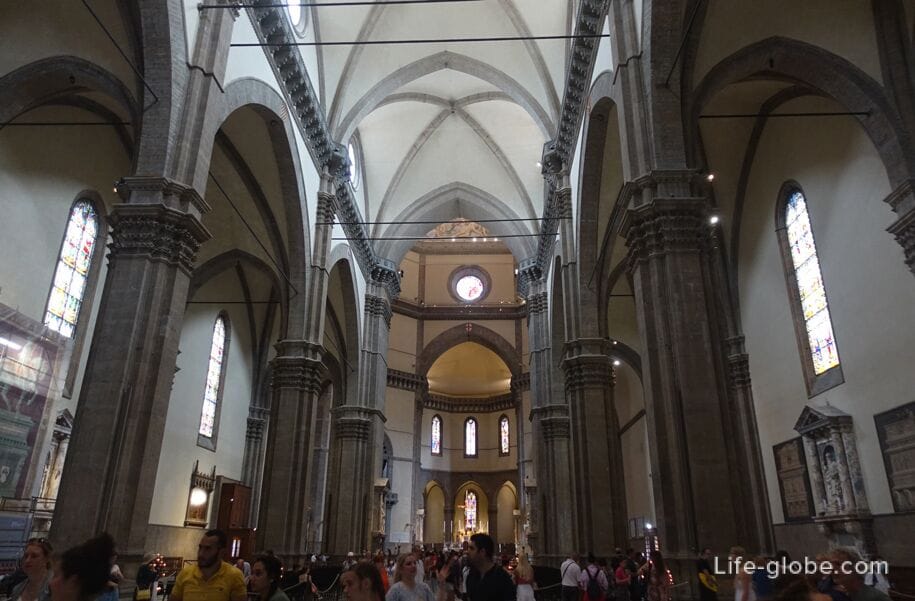
The cathedral has a huge dome called the Cupola del Brunelleschi.
The dome got its name from Filippo Brunelleschi, according to whose plans it was erected in 1420-1436.
The dome has a diameter of 45.5 meters and a total height of more than 116 meters, which makes it the largest stone vault in the world.
From the inside, the dome is painted with frescoes in 1572-1579 by Giorgio Vasari and Federico Zuccari on the theme of the Last Judgment.
You can climb up to the dome and go out to the open 360-degree observation deck, which offers stunning views of the whole of Florence and even beyond the city limits. The observation deck is located at an altitude of 92 meters. Learn more about the dome, observation deck, views and ascent…
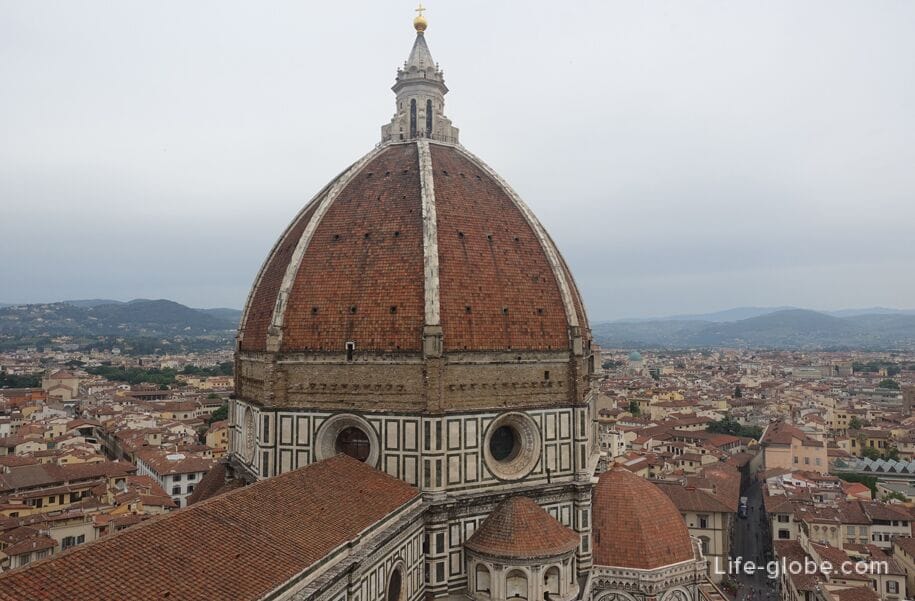
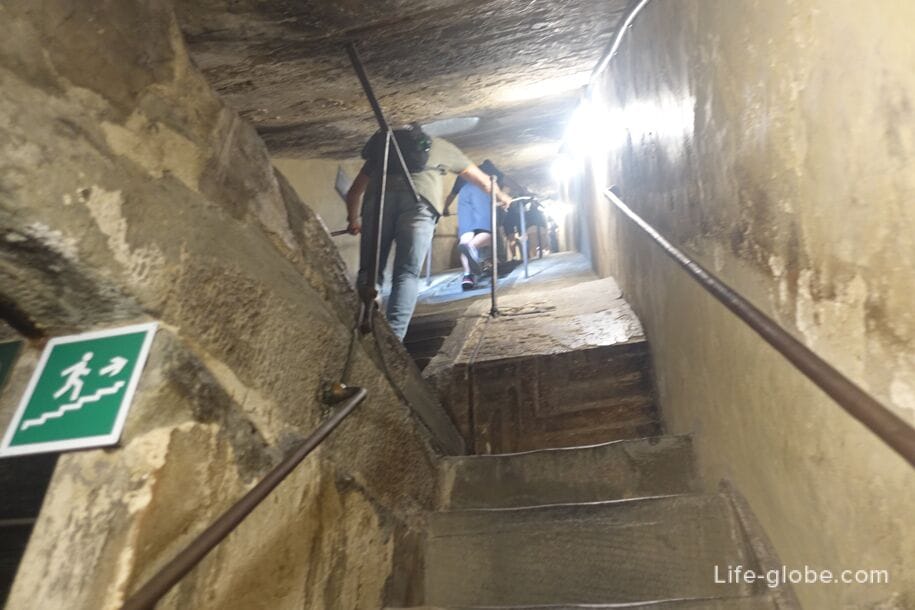

Under the cathedral (the descent from the cathedral) is the so-called crypt of Santa Reparata (Cripta Santa Reparata) - a former church, from which the remains of the former cathedral of Florence are now left, over which the current Duomo was erected.
The remains of an ancient early Christian basilica were discovered between 1965 and 1973 during excavations under the Cathedral of Santa Maria del Fiore. These remains of the ancient Basilica of Santa Reparata are the largest and most reliable evidence of early Christianity in Florence.
Here you can see the remains of walls and mosaic floors, as well as tombstones, parts of frescoes and several showcases with exhibits. More about Santa Reparata Crypt…
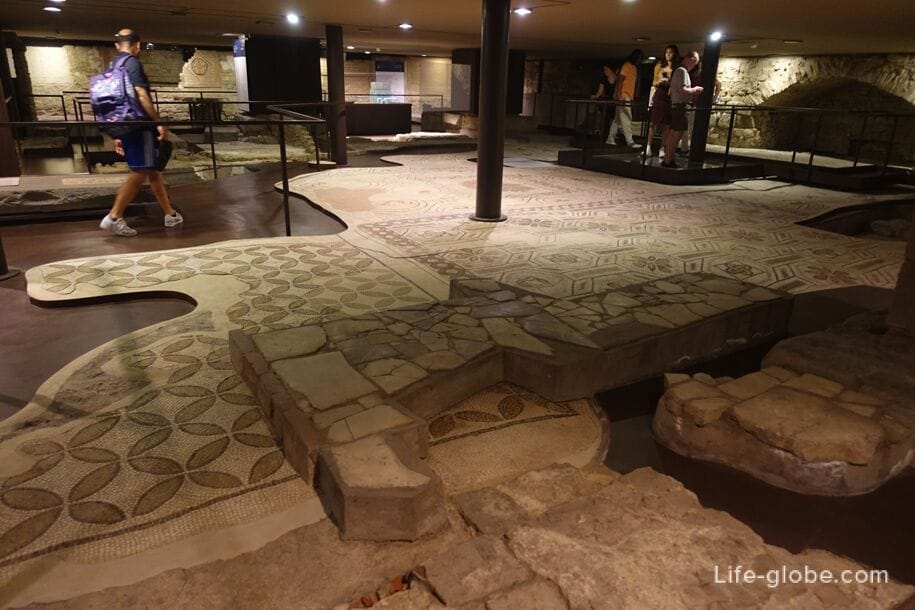
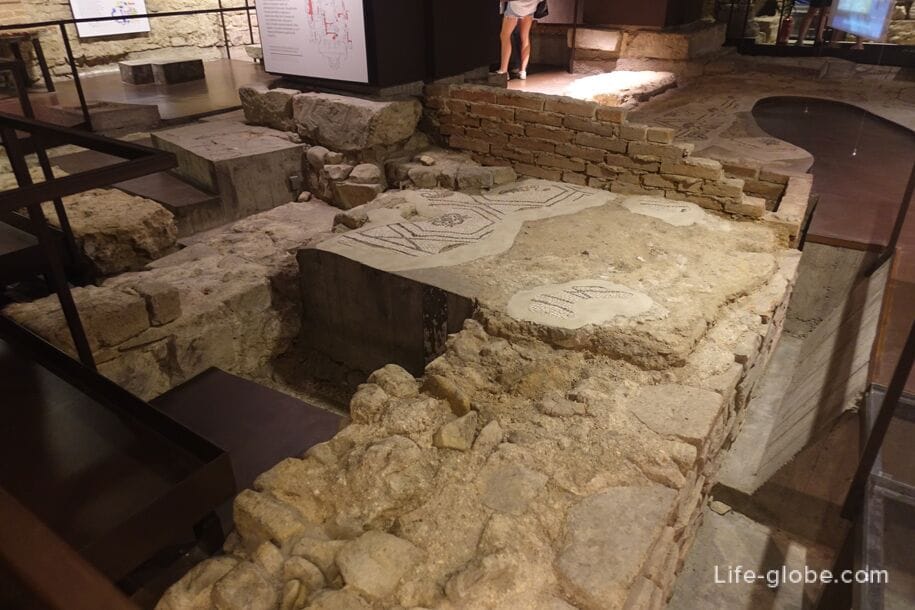
Bell Giotto
Next to the cathedral is the detached Giotto bell tower (Campanile Giotto, Campanile di Giotto), which is an outstanding example of Florentine Gothic architecture with rich sculptural decorations and polychrome marble inlays.
The bell tower received the name "Giotto" from its designer and creator of its first tier - the Italian architect and painter Giotto di Bondone.
The construction of the bell tower was started in 1334 and completed in 1359.
The bell tower is 84.7 meters high and about 15 meters wide.
The bell tower can be climbed; there (82 meters high) is a 360-degree observation deck, which offers beautiful views of Florence and the suburbs. More about Giotto's Campanile, viewing, views and ascent…

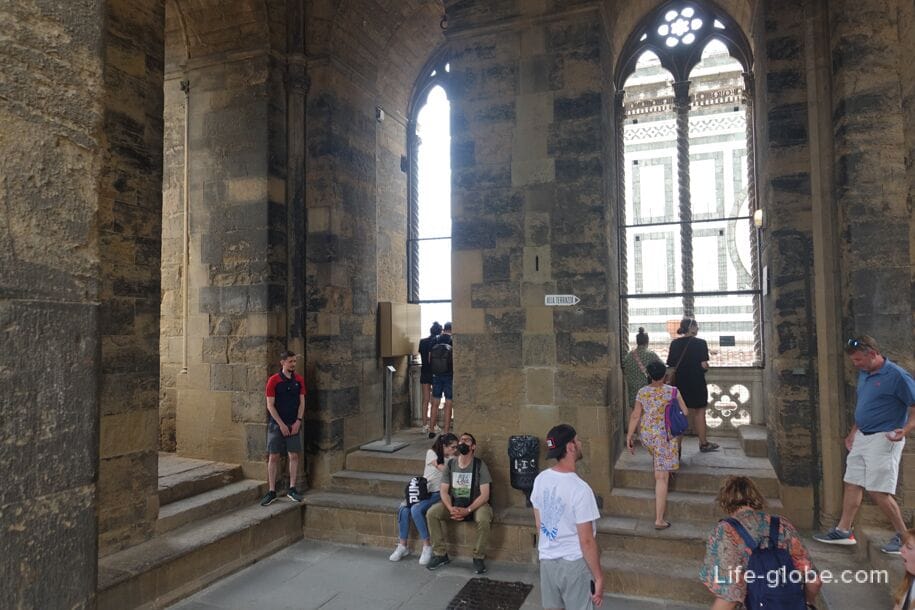
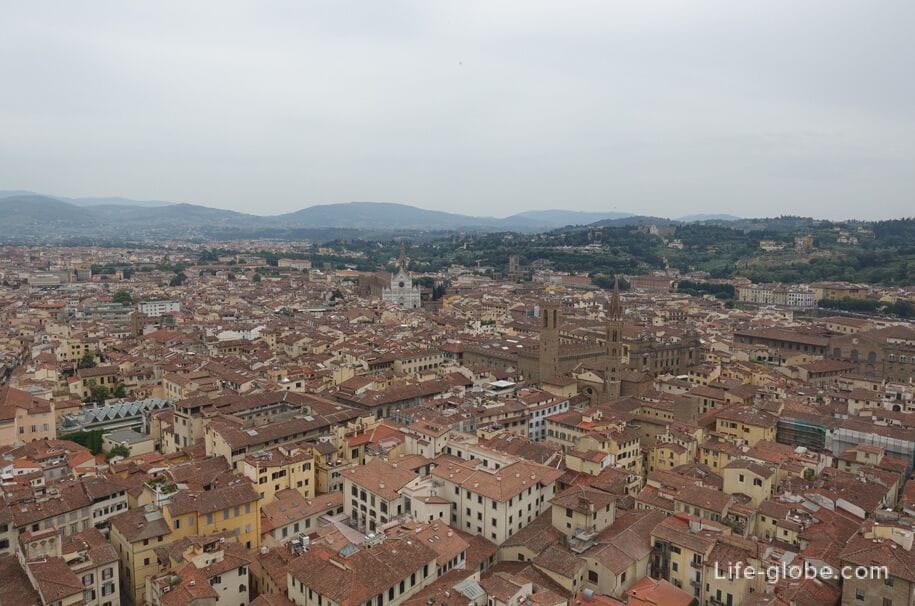
Baptistery of San Giovanni
The Baptistery of San Giovanni or Baptistery of St. John (Battistero di San Giovanni) is a medieval baptistery that has the status of a minor basilica and is one of the oldest churches in the city.
From the baptistery, the square of San Giovanni got its name.
The baptistery was built between 1059 and 1128 in the Florentine Romanesque style on the site of an ancient Roman temple of the IV-V centuries dedicated to Mars, the patron god of old Florence. The consecration of the baptistery took place on November 6, 1059 by Pope Nicholas II in honor of St. John the Baptist.
In addition to the exterior decoration in the exterior of the baptistery, doors attract attention, the most famous of which (eastern) were created in 1425-1452 by Lorenzo Ghiberti and his assistants. Michelangelo called this gate the "Gate of Paradise" because the reliefs of the doors show scenes from the Old Testament.
Inside the baptistery, the mosaic of the dome with the figure of Christ the Judge and scenes of the Last Judgment attracts attention. The monumental bronze-marble tomb of Antipope John XXIII by Donatello and Michelozzo Michelozzi also stands out. More about the Baptistery of San Giovanni…
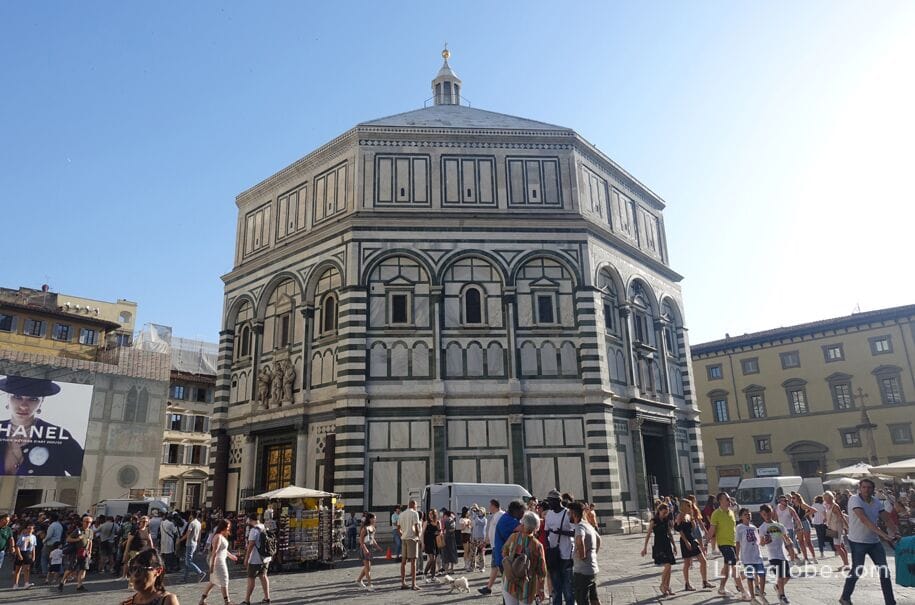
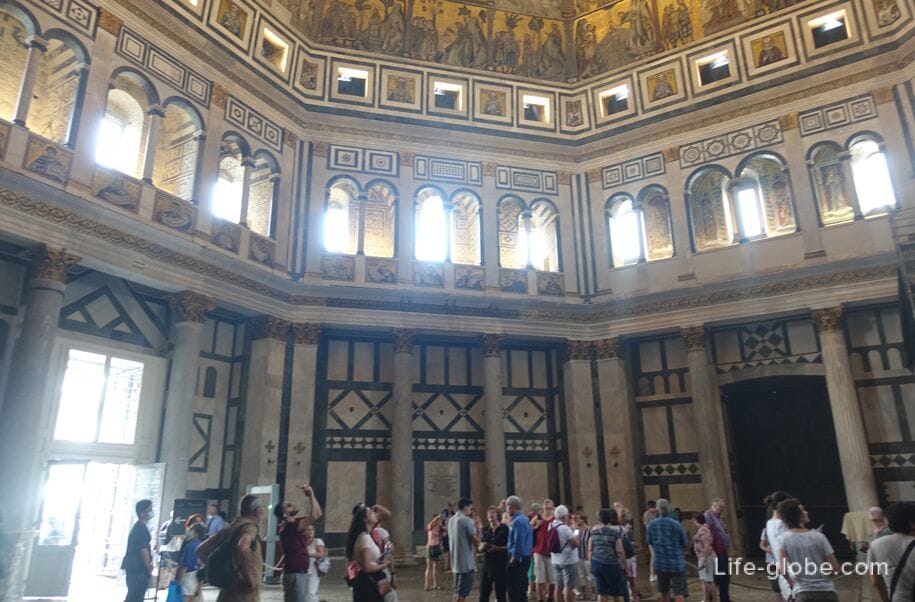
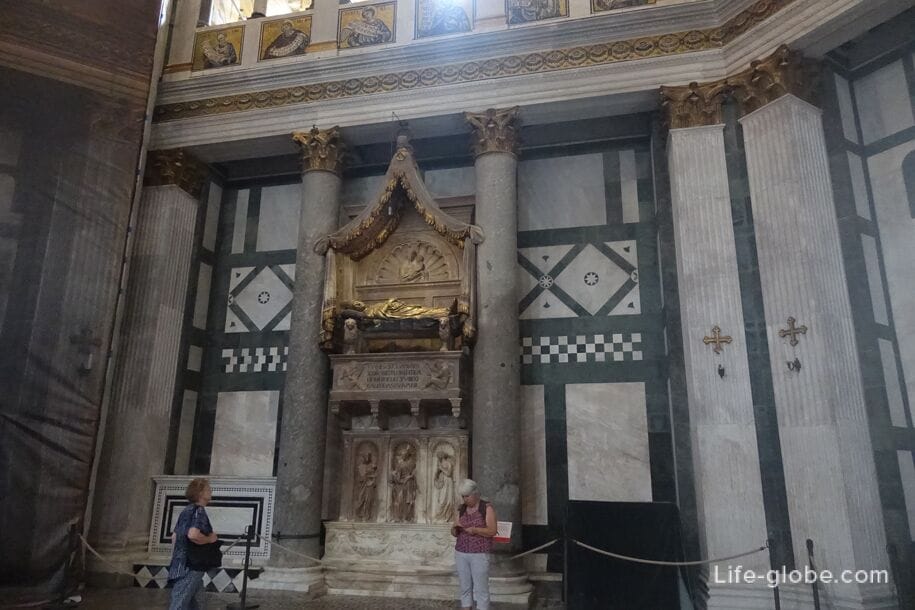
Opera Duomo Museum
The Museo dell'Opera del Duomo is a museum of the complex of the Cathedral of Santa Maria del Fiore, containing many original works of art and masterpieces created for the interiors and exteriors of both the Duomo itself and for the bell tower of Giotto and the Baptistery of San Giovanni.
Most of the important works of art of the cathedral, bell tower and baptistery during the history were removed and replaced with copies, and the originals were moved to the Duomo Museum, where they can still be seen today.
The museum is located in a historic building to the east of the cathedral, near its apse, at Piazza del Duomo 9, 50122, Florence. More about the Opera Duomo Museum...
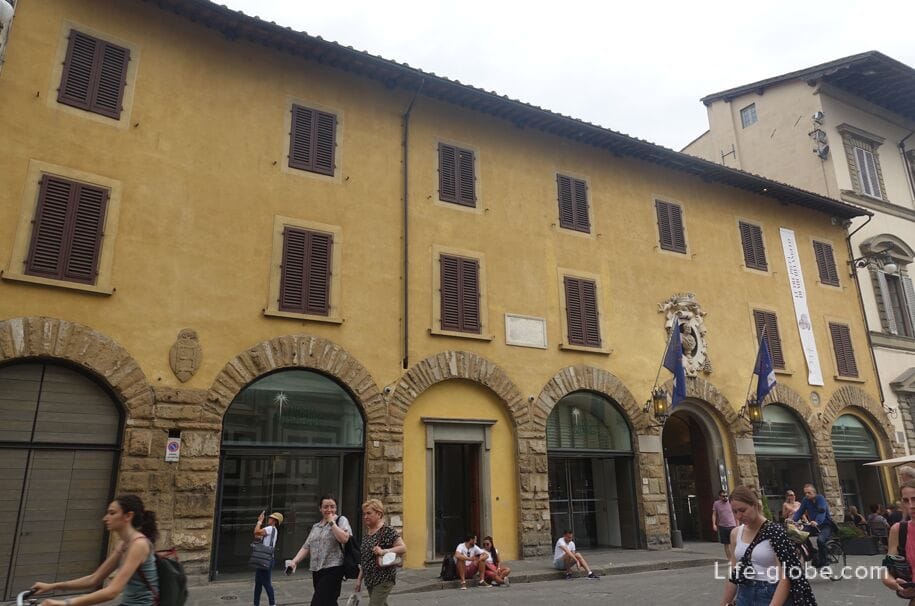
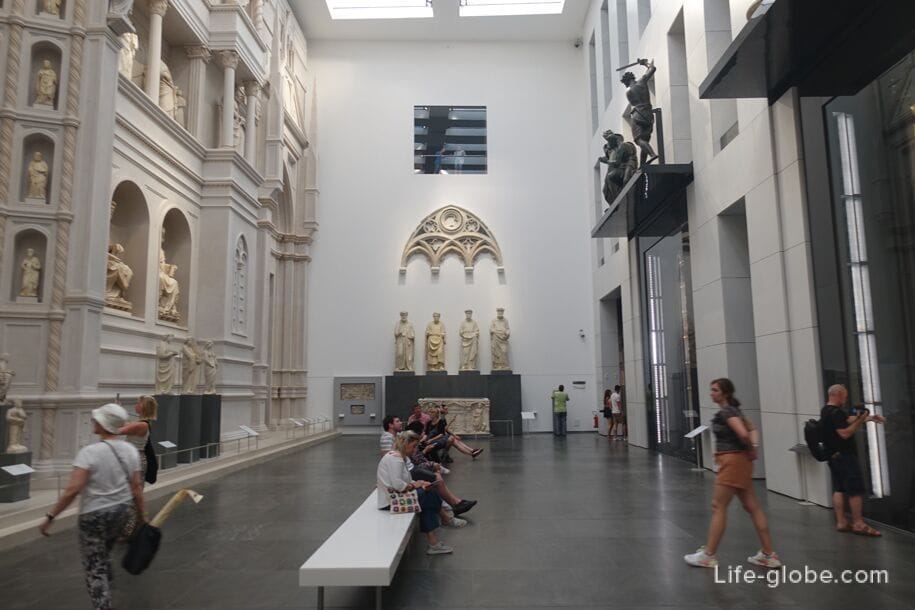
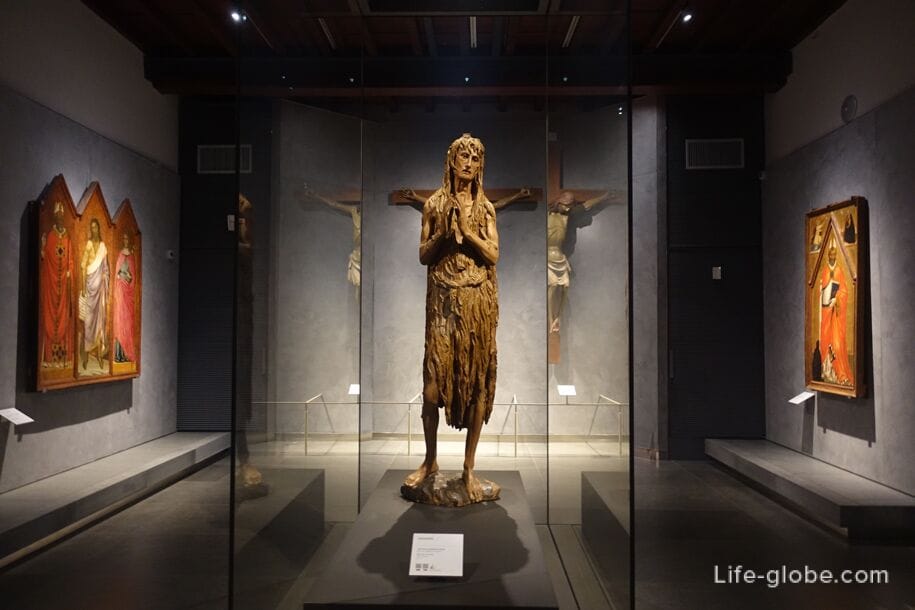
Visit to the Duomo complex
All the listed objects of the Duomo complex can be visited.
Entrance from the Cathedral of Santa Maria Del Fiore is free. Visits to other facilities of the complex are paid, and are included in complex tickets for the complex, of which there are several variations. Learn more about the complex, visits, tickets and places of purchase…
Other attractions in the Duomo and San Giovanni squares
The Column of Saint Zanobi (Colonna di San Zanobi) is a monumental marble column topped with a cross over a fiery crown.
The column was erected in memory of the miracle of the former Florentine Bishop Dzonabi of the church of Santa Reparata, who died around 430.
According to tradition, when in the winter season the remains of the saint were moved from San Lorenzo, which at that time was outside the city wall and the region was threatened by Hungarian invasions, they touched an elm tree, which began to be covered with foliage; and the column marks the place where the elm tree stood.
It is not known exactly when the column was erected, but it stood here by 1384. A metal image of a tree is placed on the column.

Loggia del Bigallo, which is part of a complex with an adjacent chapel and a former palace.
The oldest core of the complex dates back to 1321, when the captains of the Brotherhood of Mercy (Compagnia della Misericordia) purchased part of the tower house from Adimari to build their headquarters. The chapel and loggia were built by order of the same captains in 1352-1360, after the terrible plague of 1348; they were erected as places of prayer and hospitality, in particular for orphaned or abandoned children.
Today, the loggia complex houses the Bigallo Museum with some works of art.
The loggia is made in the Gothic style, and its legendary pointed arches on the ground floor were the forerunner of the Renaissance, since they are said to have inspired the architect Filippo Brunelleschi to build an orphanage (Spedale degli Innocenti) on the square of the Most Holy Annunciation (Santissima Annunziata, Piazza della Santissima Annunziata) in Florence, and, consequently, on creating a dictate of the Renaissance style.
On the facade of the loggia stand out:
- three sculptures by the Italian sculptor Alberto Arnoldi: in the center of the precious Madonna and Child and flanked by San Piero Martire, founder of the Brotherhood of Mercy, and Santa Lucia, defender of children;
- two frescoes of the late fourteenth century by Italian artists Ventura di Moro and Rossello Jacopo Franca "Stories of the preaching of San Pietro Martire in Florence", one of which is badly damaged (only some flags are visible);
- a lunette with a bas-relief of the Madonna and Child on the portal, also by Alberto Arnoldi.


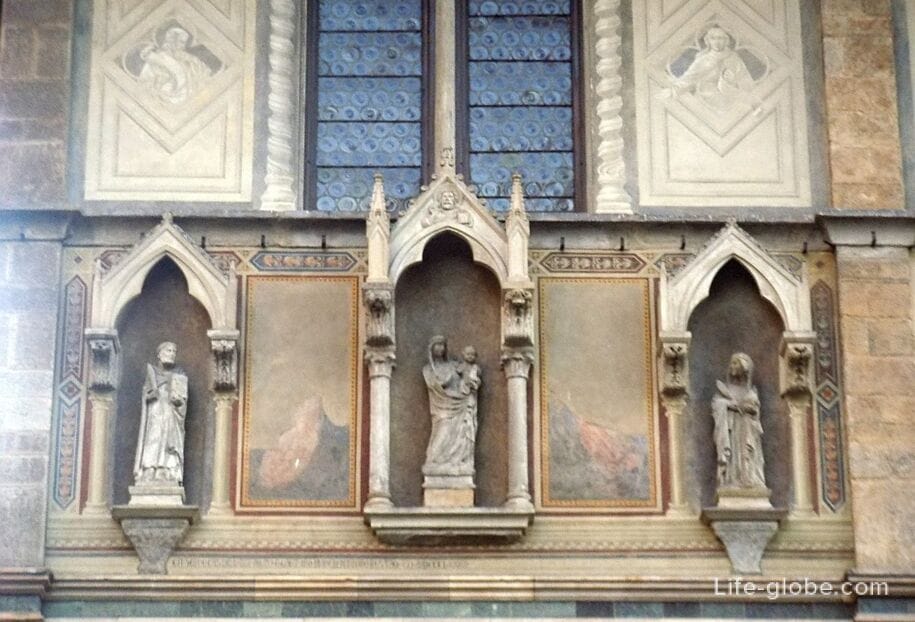
The Marignolli Tower or Lodi Focardi House (Torre dei Marignolli, casa Lodi Focardi) is a building that includes the remains of the medieval Marignolli house and, in the corner part, a fourteenth-century tower that was destroyed.
The remains of the tower have two arched portals, pontoon openings and the outlines of some buffer windows. On the corner there is a sixteenth-century tabernacle with a Madonna with Child and Angels (restored in 1995 by the Lorenzo de' Medici school) in a nineteenth-century marble frame, made according to the models of the fifteenth century (with a triangular pediment and architrave decorated with cherubs inlaid on green marble, and a base with the inscription "Ave Maria").
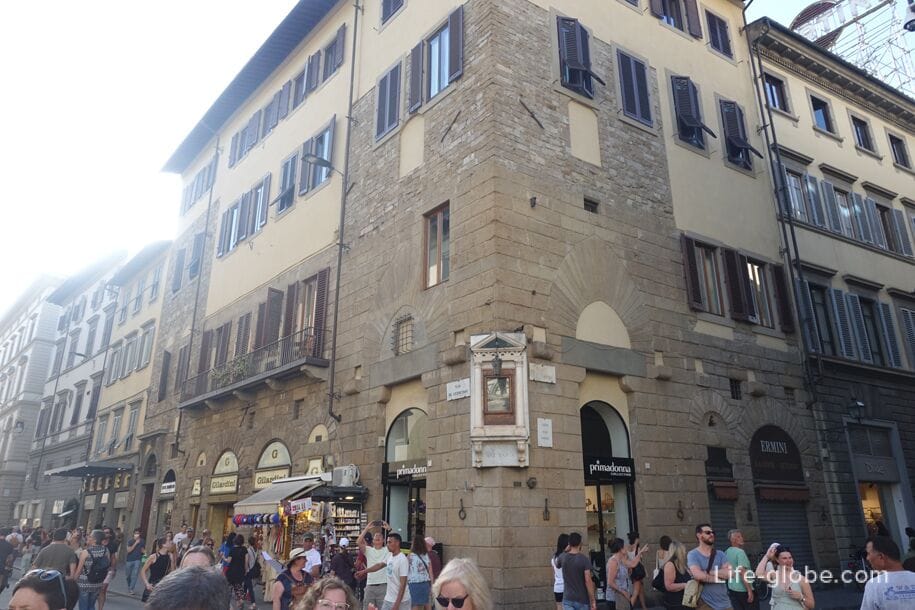
Opera San Giovanni (Opera di San Giovanni) with a courtyard, which, although reconstructed, has retained the features of the fifteenth century.
It housed the ancient rectory of the Baptistery of San Giovanni.
The facade of the building has a rough stone facade and a fifteenth-century portal topped with a lunette, in the center of which is a terracotta of San Giovanni, a copy of Michelozzo's original, which today is in the Bargello Museum of Florence.

The Archiepiscopal Palace (Palazzo Arcivescovile), an ancient building that has existed on this site since about the 8th century.
The ancient archbishopric was destroyed by fire in 1533 and restored by the architect Giovanni Antonio Dosio between 1573 and 1584. The then Archbishop Alessandro di Ottaviano de' Medici (later Pope Leo XI) placed the family coat of arms on the northern corner of the palace.
The Archiepiscopal complex was completely renovated between 1893 and 1895, when the old bishop's house next to the baptistery was demolished and the sixteenth-century facade was slightly rebuilt to expand Piazza San Giovanni. In 1895, the coat of arms of Archbishop Agostino Baus, who supervised the work, was placed on the southern corner of the palace.

Coat of arms of Leo XI

Coat of arms of Agostino Bausa

Palace of Canonici (Palazzo dei Canonici), built during the expansion of Duomo Square.
From 1826 to 1830, architect Gaetano Baccani demolished the old buildings and erected three large buildings in a row of canons' houses. The central palace was enriched with a balcony supported by four columns framing two niches with statues depicting the architects of the Florence Cathedral: Arnolfo di Cambio and Filippo Brunelleschi, executed by Luigi Pampaloni in 1830.
Today, the building houses the information center and ticket offices of the Duomo complex.

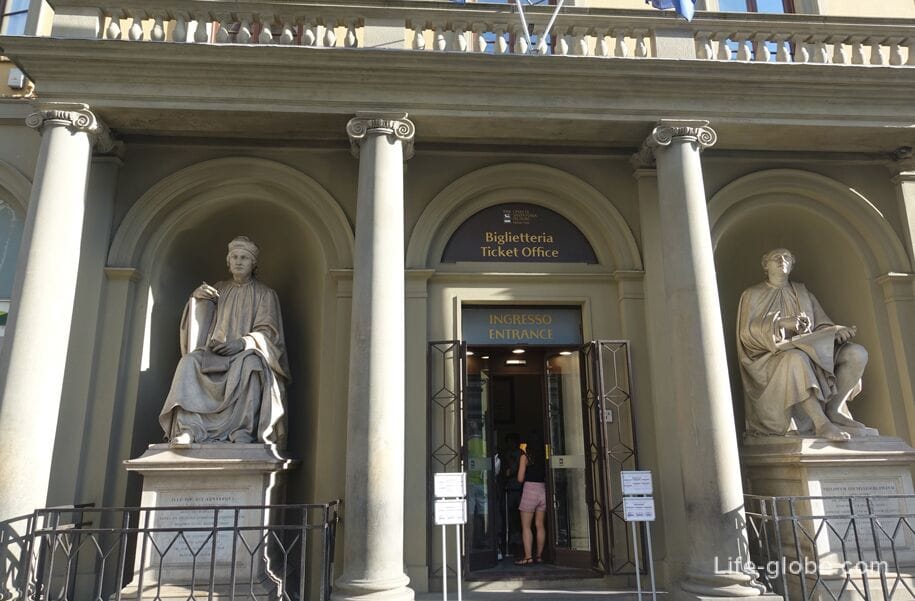
Strozzi di Mantova Palace or Guadagni Sacrati (Palazzo Strozzi di Mantova, Guadagni-Sacrati), which was built on the old houses of the Bicheri family.
The building in 1596 passed to a branch of the Guadagni family, which was named Guadagni del Opera because of its proximity to the Opera del Duomo building. Work on the modification and expansion of the palace began in 1604 and was carried out several times. During its history, the palace also belonged to the Riccardi-Strozzi family.
The building was bought in 1989 by the Tuscany region. After careful restoration, the former palace houses the offices of the council and is the registered office of the region.
The facade of the palace presents the canonical elements of Florentine residential architecture of the Renaissance. Also on the facade is the coat of arms of Guadagni: a golden cross with jagged edges on a blue background. On the other hand, on the facade facing Oriuolo Street (Via dell' Oriuolo), there is the coat of arms of Riccardi-Strozzi.
The house has a courtyard with arcades. In the interior there are traces of frescoes of the 18th century, as well as the grand staircase, frescoes and stucco molding of the 19th century.
Website: palazzo-guadagni-strozzi-sacrati.

The Duomo and San Giovanni squares are also home to: the Museum of Mercy (Misericordia, Museo della Misericordia), dedicated to San Sebastiano, the merciful patron saint of Tuscany; and the Torrini Museum-shop (Museo Torrini), which tells about the activities of the Torrini jewelry dynasty with its history since the seventeenth century.
Where to stay in the Duomo and San Giovanni squares
On and near the Duomo and San Giovanni squares, which means in the very center of Florence, which is very convenient for walking and exploring the sights of the city, you can stop:
Flower Cathedral Firenze Guesthouse
Relais Panoramic Cathedral Florence Apartment
All accommodation facilities in Florence (hotels, apartments, guest houses, etc.), including those in the historic city center, near the Duomo Square and more remotely from those, can be view and book here
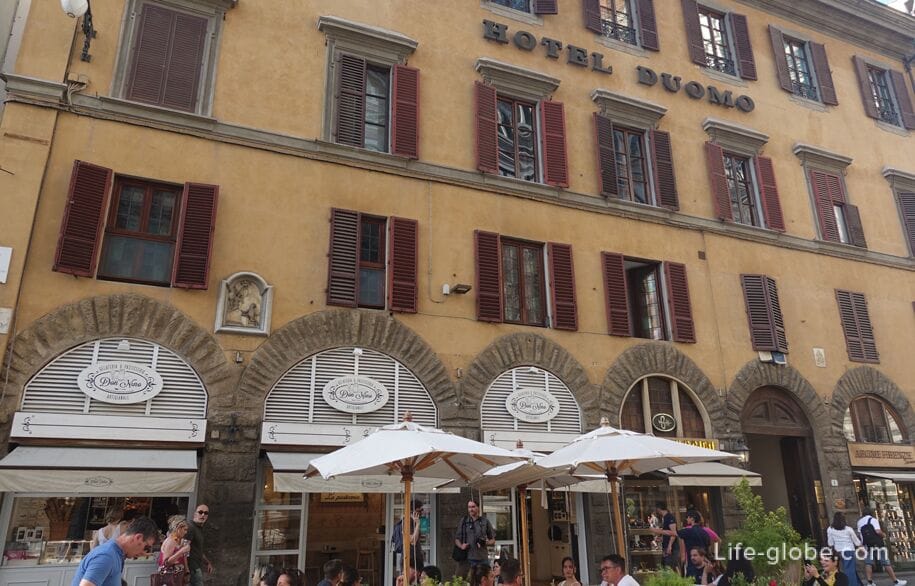
Practical information
The Duomo Square is a privileged place to celebrate the main religious holidays in the city. Among the most important celebrations are Easter and the feast of St. John the Baptist (June 24), the patron saint of Florence.
The Duomo and San Giovanni squares are open to the public 24 hours a day.
Coordinates of the Duomo and San Giovanni squares: 43°46'22.0"N 11°15'23.0"E (43.772778, 11.256389).






